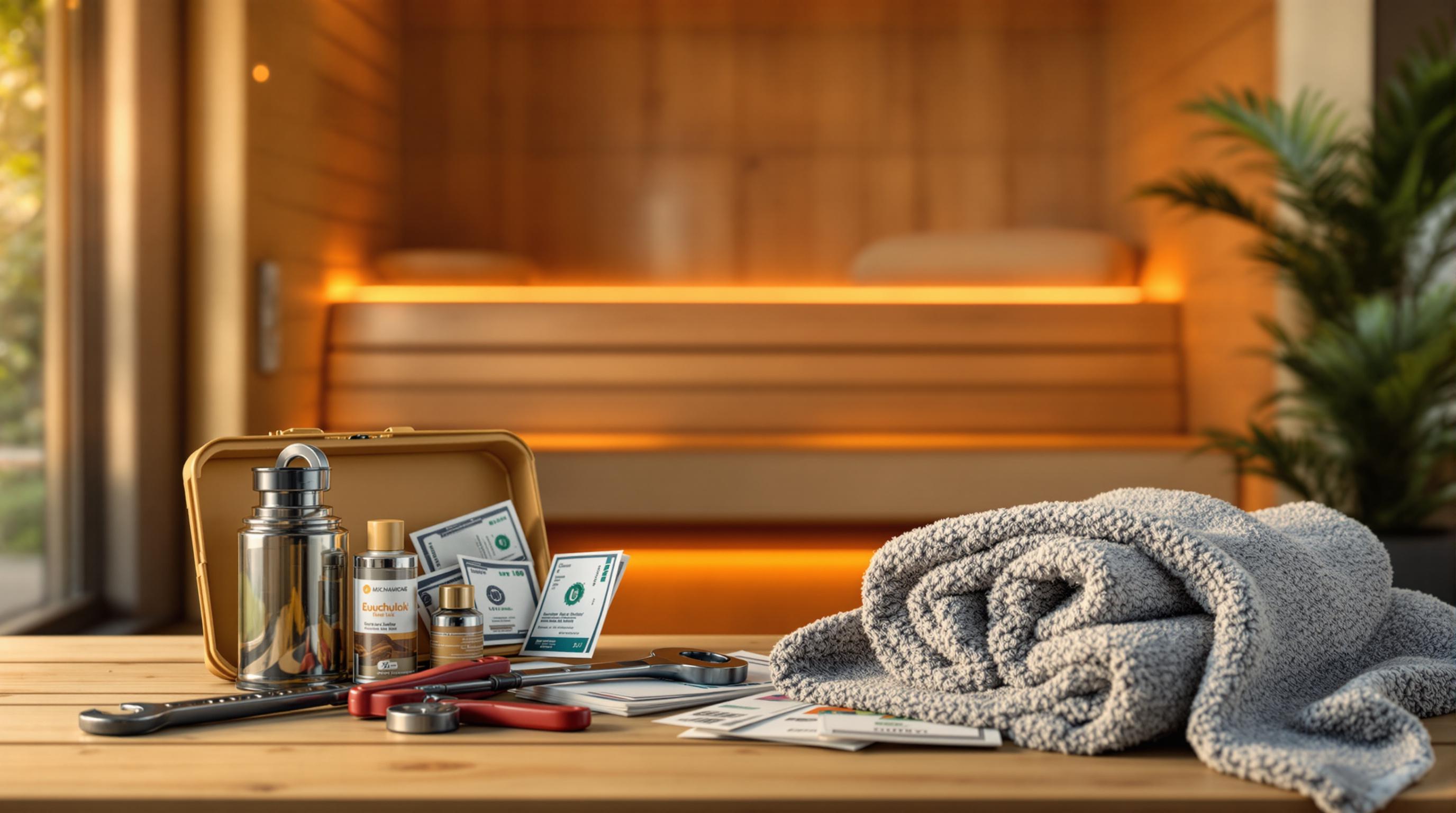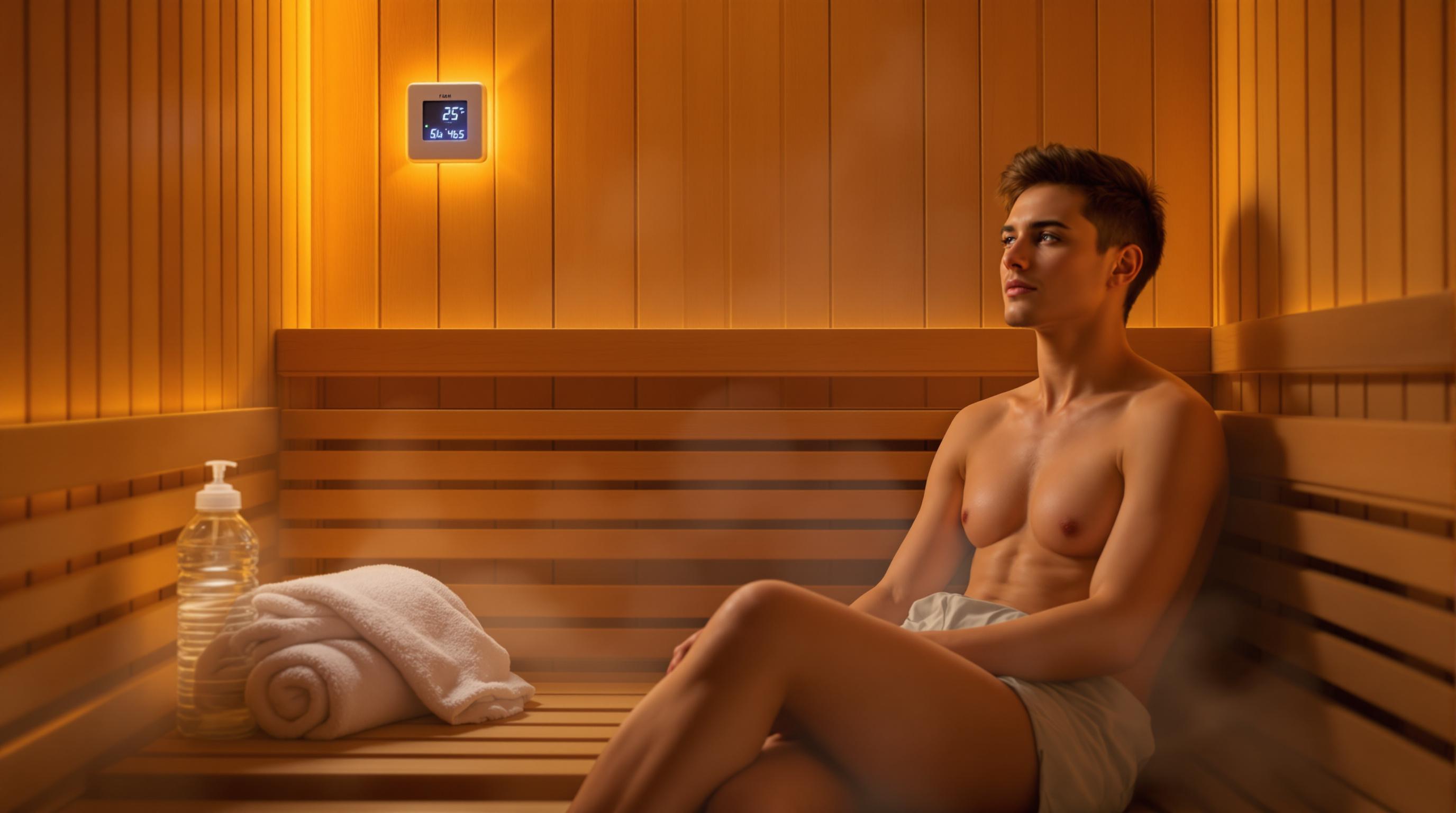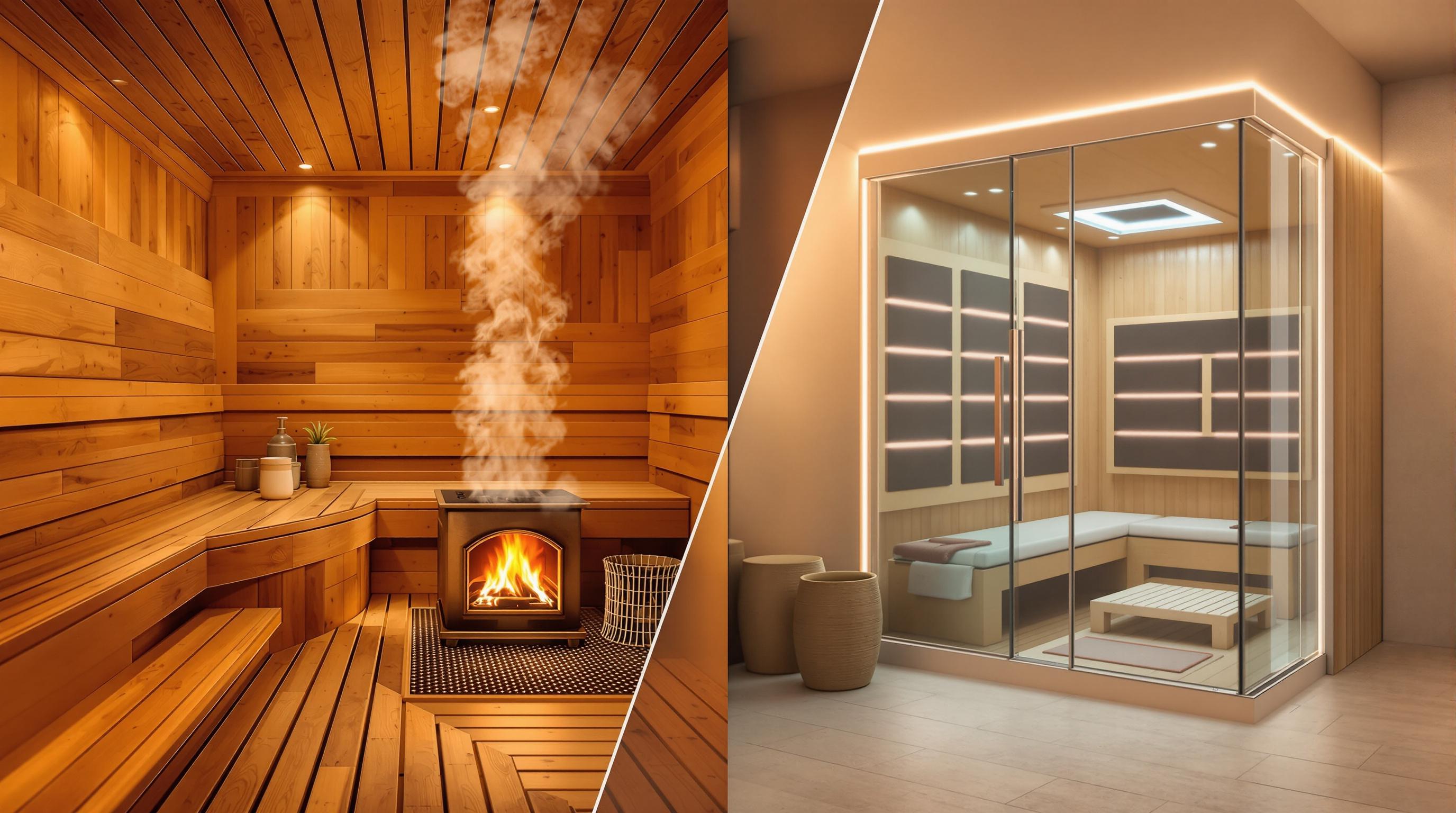Proper sauna ventilation is essential for comfort, safety, and longevity. Poor ventilation can lead to uneven heating, excess moisture, and even mold growth, which can damage your sauna and make it unsafe to use. Below are five common mistakes to avoid when planning or maintaining sauna ventilation:
- Skipping Ventilation Planning: Neglecting ventilation during the design phase results in uneven heat and moisture issues that are costly to fix later.
- Incorrect Vent Placement: Poor vent positioning disrupts air circulation, causing drafts, stagnant air, or trapped moisture.
- Insufficient Vent Size: Too few or too small vents restrict airflow, leading to overheating, trapped humidity, and structural damage.
- Mixing Air Systems: Combining indoor mechanical and outdoor natural airflow creates inconsistent circulation and heat distribution.
- Ignoring Outdoor Needs: Outdoor saunas face unique challenges like temperature swings and humidity, requiring tailored ventilation solutions.
Key takeaway: Plan ventilation during construction to ensure even heat, proper moisture management, and a longer-lasting sauna. Addressing these issues upfront saves time, money, and hassle down the line.
How to Ventilate a Sauna
1. Poor Ventilation Planning
Overlooking proper ventilation can lead to uneven heating, poor air quality, and excess moisture - issues that not only affect the sauna's performance but also its longevity. Often, builders prioritize heating systems and insulation while treating ventilation as an afterthought. Unfortunately, this makes it harder to maintain a stable temperature and a safe, comfortable environment.
The best time to tackle ventilation is during the design phase. By carefully positioning intake and exhaust vents from the start, you can ensure your sauna operates efficiently, whether it's indoors or outdoors. Early planning helps maintain consistent heat, improve air circulation, and protect your sauna from unnecessary wear and tear.
2. Wrong Vent Placement
Poorly placed vents can throw off the efficiency and comfort of a sauna. Builders sometimes install intake and exhaust vents without fully considering how air naturally flows within the space. This oversight often leads to uneven temperatures and areas of stagnant air, creating a less-than-ideal sauna experience.
Impact on Heat Distribution and Air Quality
When vents are incorrectly positioned, warm air can collect near the ceiling while cooler air remains trapped closer to the floor. For example, placing the intake and exhaust vents directly across from each other at the same height can prevent proper air mixing. This setup creates drafts and leaves some areas feeling stuffy or cold.
To optimize airflow, place the intake vent above the heater and the exhaust vent lower on the opposite wall or diagonally across the room. This arrangement encourages a natural convection loop: warm air rises, circulates evenly, and exits through the lower vent.
Risk of Moisture Buildup and Mold
Improper vent placement can also trap humid air, increasing the risk of mold growth and damaging the wood over time. High or poorly located exhaust vents are particularly problematic, as they fail to remove moisture effectively.
Importance of Planning During Construction
Fixing vent placement after construction is both expensive and disruptive. That’s why it’s crucial to plan vent locations early in the design phase. Marking these spots on your plans before framing allows electricians and HVAC professionals to install wiring and ductwork in the correct positions from the start. A little planning here saves a lot of hassle later.
Considerations for Indoor and Outdoor Saunas
Indoor and outdoor saunas have different airflow needs. Indoor saunas require vent placements that work in harmony with existing HVAC systems, while outdoor saunas depend on passive airflow. For outdoor setups, place intake vents away from prevailing winds, and position exhaust vents in open areas to allow moisture to escape. Adjusting vent sizes can also help account for temperature differences in outdoor environments.
3. Too Few or Too Small Vents
Getting vent sizing wrong is a common misstep that can seriously mess with airflow in a sauna. Many builders mistakenly think a couple of small vents will do the trick, but this often leads to discomfort and even safety concerns. Starting with vents that are too small sets the stage for a range of ventilation problems.
To ensure proper airflow, vent openings need to match the sauna's size. If the vents are too small, airflow becomes restricted, forcing the heater to work harder than it should. This can lead to uneven heating, leaving some areas - like the benches - cold and uninviting. Poor airflow also limits air exchange, which can make the space feel stuffy and unpleasant during longer sessions.
Small vents don't just affect comfort - they can cause structural problems too. Without adequate air exchange, moisture can build up and condense on walls and benches. Over time, this creates the perfect environment for mold growth and can lead to damage in the wood.
The best time to address vent sizing is during the construction phase. Adding larger or extra vents upfront is much simpler and cheaper than trying to fix the issue later. Retrofitting vents in a completed sauna often means cutting through walls and making structural changes, which can be a headache.
Whether you're working on an indoor or outdoor sauna, vent sizing needs careful planning. Indoor saunas rely on mechanical airflow and are particularly sensitive to undersized vents. Outdoor saunas, on the other hand, need larger openings to take advantage of natural convection and deal with changing weather conditions. Getting the vent size right from the start is key to avoiding bigger air circulation problems down the line.
sbb-itb-3953eb0
4. Mixing Indoor and Outdoor Air Paths
One common mistake in sauna design is trying to combine indoor mechanical ventilation with outdoor natural airflow. These two systems are fundamentally different, and merging them often leads to unpredictable airflow and diminished sauna performance.
Indoor saunas rely on mechanical systems with carefully placed intake and exhaust points to manage air circulation. Outdoor saunas, on the other hand, depend on natural ventilation, using larger openings that adapt to weather changes. When these two methods are mixed, neither functions as intended, leading to issues with heat distribution, moisture control, and installation challenges.
Impact on Heat Distribution and Air Quality
Blending mechanical and natural ventilation disrupts airflow, making it harder to maintain consistent heat distribution. This imbalance can also negatively affect air quality, creating a less comfortable and less efficient sauna experience.
Risk of Moisture Buildup or Mold
When air paths are mixed, dead zones with poor circulation can form, allowing moisture to accumulate. These damp areas are prime conditions for mold and mildew growth, which can damage materials and reduce the sauna's lifespan.
Challenges During Construction
Combining ventilation systems complicates the installation process and makes it harder to comply with building codes. A lack of a clear and consistent ventilation strategy can lead to delays and additional costs during construction.
Choosing the Right Ventilation for Your Sauna
Indoor saunas work best with dedicated mechanical systems that include properly sized intake and exhaust fans. These systems ensure a controlled environment with efficient air circulation. Outdoor saunas, however, thrive on natural ventilation designs that take advantage of prevailing winds and thermal currents. Introducing mechanical components to outdoor setups can lead to unnecessary risks, such as equipment failure.
The bottom line? Stick to one ventilation method and optimize it for your specific setup. A focused approach ensures better performance, easier construction, and a more enjoyable sauna experience.
5. Ignoring Outdoor Sauna Ventilation Needs
When it comes to outdoor saunas, ventilation is often underestimated. Many assume that outdoor setups naturally circulate air, but this misconception can lead to serious problems like mold growth and structural damage. Unlike indoor saunas, outdoor models face unique challenges such as exposure to the elements, temperature swings, and moisture retention. These factors demand ventilation solutions specifically designed for outdoor use.
Impact on Air Quality
Without proper airflow, stagnant air in a sauna can harbor bacteria and reduce oxygen levels, taking away from the health benefits saunas are known for.
Risk of Moisture Buildup or Mold
Good ventilation does more than just improve air quality - it’s essential for managing moisture levels. Outdoor saunas, in particular, are prone to mold because fluctuating temperatures and humidity create ideal conditions for its growth. Research shows that mold species like C. cladosporioides can thrive even in environments with just 40% relative humidity. Without the right ventilation, moisture gets trapped inside, leading to mold and mildew on wooden surfaces.
The problem doesn’t stop there. Moisture can seep into wall cavities, causing hidden damage that’s both costly to repair and potentially harmful to the sauna’s structural integrity. Mold not only damages materials but can also trigger allergic reactions and respiratory issues for users within 48 hours of exposure to its spores.
Ease of Implementation During Construction
Planning for proper ventilation during the construction phase is much easier than trying to fix issues later. Incorporate features like external vents, exhaust fans, and vapor barriers right from the start. These measures help prevent moisture from accumulating inside the walls, keeping the sauna dry and functional.
Suitability for Indoor or Outdoor Saunas
Unlike indoor saunas, which often use controlled mechanical systems, outdoor saunas benefit from designs that take advantage of natural airflow. Simple steps like leaving the door open after use and regularly airing out the space can help reduce humidity quickly. Keeping humidity levels between 10–20% is key to preventing mold growth. Even during times when the sauna isn’t in use, regular ventilation ensures a healthy environment and protects your investment for the long term. Good airflow not only dries the sauna faster but also enhances air quality, making every session more enjoyable.
Comparison Table
To better understand the impact of sauna ventilation, let’s break down the differences between proper and improper setups. The table below compares key aspects like CO2 levels, air quality, and overall user experience.
| Aspect | Proper Ventilation | Improper Ventilation |
|---|---|---|
| CO2 Levels | Keeps levels below 700 ppm - ideally under 500 ppm, mimicking fresh outdoor air at about 380 ppm. | Can spike above 3,000 ppm in crowded saunas. Poorly ventilated U.S. saunas often hit around 2,239 ppm within 20 minutes with six people. |
| Air Quality | Removes VOCs, mold, bacteria, sweat odors, and particulate matter, leaving the air clean and fresh. | Creates a stale, unhealthy environment prone to odors and contaminants. |
| Heat Distribution | Ensures even warmth from head to toe, avoiding cold feet or hot spots. | Causes uneven heating, with noticeable temperature differences like a hot head and cold feet. |
| User Experience | Supports longer, more enjoyable sessions with easy breathing. | Leads to discomfort and stuffy air. |
| Health Impact | Maintains safe CO2 levels, preventing dizziness and cognitive issues. | High CO2 levels can cause dizziness, reduced focus, and impaired performance, with effects starting around 550–600 ppm. |
| Maintenance Needs | Supports high temperatures that naturally kill bacteria and mold, while aiding in proper drying between uses. | Creates damp conditions that encourage mold and bacteria growth, increasing upkeep demands. |
These differences affect not only the air you breathe but also your health and the longevity of the sauna itself. Without proper ventilation, CO2 builds up rapidly - levels as low as 500 ppm can disrupt sleep, and cognitive issues may start at 550 ppm.
"There is no shortcut to perfect löyly, it is always about stones and proper ventilation."
– Jesse Hämäläinen, Narvi Sauna Heaters, Finland, 2012
Research by the Finnish Sauna Society reveals that a well-ventilated sauna, designed with 2 cubic meters per person and six air changes per hour, keeps CO2 levels between 582 and 606 ppm during three 15-minute rounds. In contrast, 90% of North American saunas are poorly ventilated, with experts lamenting that "the other 10% are worse."
Proper ventilation doesn’t just ensure healthier air - it creates what enthusiasts describe as a "gentle breeze of heat", delivering consistent warmth throughout the sauna. On the flip side, poor ventilation disrupts this balance, often leaving you with an overheated head and chilly feet.
Conclusion
Effective sauna ventilation isn’t just a nice-to-have - it’s a must for safety, comfort, and long-term durability. Poorly planned vents, improper placement, or incorrect sizing can create uneven heat, trap moisture, and lead to costly repairs. Even mixing indoor and outdoor air improperly can throw off the balance needed for your sauna to work as it should. And yes, even outdoor saunas need careful ventilation planning to perform well.
Good ventilation does more than just keep the air flowing - it ensures consistent heat, prevents moisture damage, and helps your sauna last longer. Every decision, from where you place vents to how much airflow you allow, directly influences how well your sauna performs and how long it will serve you. Early planning is key to avoiding problems like mold or uneven heating down the line.
Ready to take the plunge? If you’re thinking about adding a sauna to your home, Find the Home Sauna of Your Dreams can help you explore models designed with proper ventilation in mind. Whether you’re leaning toward infrared, steam, or traditional setups, choosing a sauna with smart airflow design will ensure years of relaxing, worry-free enjoyment.
FAQs
What’s the best way to size and position sauna vents for proper airflow?
To achieve proper airflow in your sauna, start by placing an intake vent near the floor, preferably beneath the heater, to draw in fresh, cool air. Then, position the exhaust vent on the opposite wall, closer to the ceiling, to let the warm air escape. Ideally, there should be at least an 8-inch height difference between the two vents to encourage effective air circulation.
When it comes to vent sizing, a good guideline is one vent for every 50 cubic feet of sauna space. For larger saunas, adjust this proportionally. Correctly sized and strategically placed vents ensure better heat distribution, maintain steady temperatures, and enhance the overall sauna experience.
What are the unique challenges of ventilating an outdoor sauna, and how can they be addressed?
Ventilating an outdoor sauna brings its own set of challenges, mainly because it’s exposed to elements like wind, rain, and moisture. Without proper planning, these factors can lead to moisture buildup, mold, and poor airflow - issues that can quickly compromise the sauna’s performance.
A smart solution is to install weatherproof vents in key locations. These vents should encourage steady airflow while keeping out rain, debris, and pests. It’s also important to choose sturdy, weather-resistant materials for all ventilation components to ensure they hold up against the elements. When designing the system, consider local wind patterns and humidity levels to maintain reliable air circulation.
Unlike indoor saunas, which deal with humidity in a controlled space, outdoor saunas demand extra care to manage external conditions. With thoughtful planning and the right materials, you can ensure your outdoor sauna stays comfortable and functional for years to come.
Why shouldn’t you combine indoor mechanical and outdoor natural ventilation systems in a sauna?
Combining mechanical ventilation with natural airflow in a sauna might seem like a good idea, but it can actually throw off the balance of proper airflow. This mismatch can result in uneven heat distribution, leading to problems like too much moisture, fluctuating temperatures, and even poor air quality - all of which can impact both comfort and safety.
To get the most out of your sauna, it’s crucial to have a ventilation system that’s thoughtfully designed for your specific setup. This ensures efficient heat circulation and maintains a comfortable, enjoyable environment.


